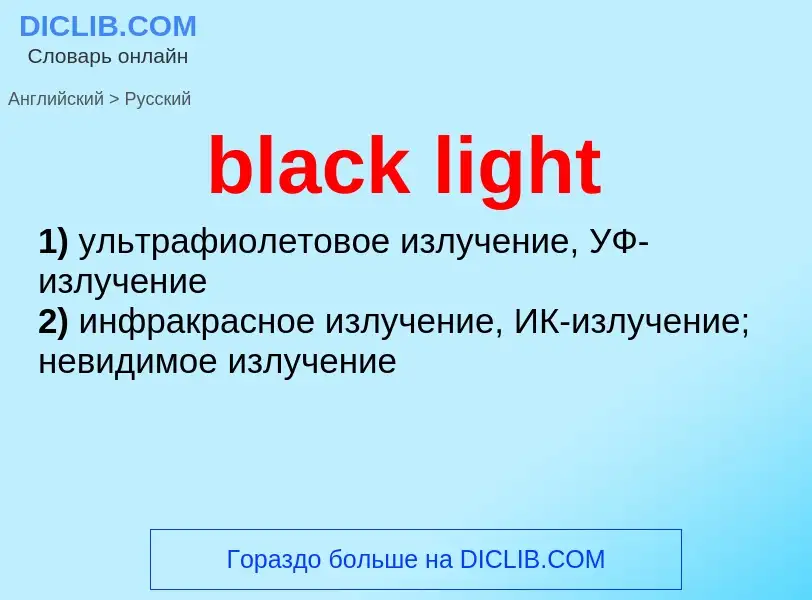Übersetzung und Analyse von Wörtern durch künstliche Intelligenz ChatGPT
Auf dieser Seite erhalten Sie eine detaillierte Analyse eines Wortes oder einer Phrase mithilfe der besten heute verfügbaren Technologie der künstlichen Intelligenz:
- wie das Wort verwendet wird
- Häufigkeit der Nutzung
- es wird häufiger in mündlicher oder schriftlicher Rede verwendet
- Wortübersetzungsoptionen
- Anwendungsbeispiele (mehrere Phrasen mit Übersetzung)
- Etymologie
black light - Übersetzung nach russisch
[blæk'lait]
физика
невидимый свет (инфракрасный или ультрафиолетовый)
существительное
физика
невидимый свет (инфракрасный или ультрафиолетовый)
Definition
Wikipedia

A blacklight, also called a UV-A light, Wood's lamp, or ultraviolet light, is a lamp that emits long-wave (UV-A) ultraviolet light and very little visible light. One type of lamp has a violet filter material, either on the bulb or in a separate glass filter in the lamp housing, which blocks most visible light and allows through UV, so the lamp has a dim violet glow when operating. Blacklight lamps which have this filter have a lighting industry designation that includes the letters "BLB". This stands for "blacklight blue". A second type of lamp produces ultraviolet but does not have the filter material, so it produces more visible light and has a blue color when operating. These tubes are made for use in "bug zapper" insect traps, and are identified by the industry designation "BL". This stands for "blacklight".
Blacklight sources may be specially designed fluorescent lamps, mercury-vapor lamps, light-emitting diodes (LEDs), lasers, or incandescent lamps. In medicine, forensics, and some other scientific fields, such a light source is referred to as a Wood's lamp, named after Robert Williams Wood, who invented the original Wood's glass UV filters.
Although many other types of lamp emit ultraviolet light with visible light, black lights are essential when UV-A light without visible light is needed, particularly in observing fluorescence, the colored glow that many substances emit when exposed to UV. Black lights are employed for decorative and artistic lighting effects, diagnostic and therapeutic uses in medicine, the detection of substances tagged with fluorescent dyes, rock-hunting, scorpion-hunting, the detection of counterfeit money, the curing of plastic resins, attracting insects and the detection of refrigerant leaks affecting refrigerators and air conditioning systems. Strong sources of long-wave ultraviolet light are used in tanning beds.
UV-A presents a potential hazard when eyes and skin are exposed, especially to high power sources. According to the World Health Organization, UV-A is responsible for the initial tanning of skin and it contributes to skin ageing and wrinkling. UV-A may also contribute to the progression of skin cancers. Additionally, UV-A can have negative effects on eyes in both the short-term and long-term.


![Compact fluorescent]] (CF) black light bulb Compact fluorescent]] (CF) black light bulb](https://commons.wikimedia.org/wiki/Special:FilePath/Black light bulb.jpg?width=200)

![[[Fluorescein]] glowing under ultraviolet light [[Fluorescein]] glowing under ultraviolet light](https://commons.wikimedia.org/wiki/Special:FilePath/Fluorescein.jpg?width=200)
![FWHM]] spectral bandwidth of the 370 nm peak is about 20 nm. The tiny secondary peak ''(2)'' is light from the mercury vapor line at 404 nm leaking through the filter, which gives the lamp its purple glow. FWHM]] spectral bandwidth of the 370 nm peak is about 20 nm. The tiny secondary peak ''(2)'' is light from the mercury vapor line at 404 nm leaking through the filter, which gives the lamp its purple glow.](https://commons.wikimedia.org/wiki/Special:FilePath/Fluorescent Black-Light spectrum with peaks labelled.gif?width=200)

![[[Uranium glass]] glows under UV light. [[Uranium glass]] glows under UV light.](https://commons.wikimedia.org/wiki/Special:FilePath/U glass with black light.jpg?width=200)

![US $20 bill]] glows green under black light as a safeguard against [[counterfeit]]ing. US $20 bill]] glows green under black light as a safeguard against [[counterfeit]]ing.](https://commons.wikimedia.org/wiki/Special:FilePath/US $20 under blacklight.jpg?width=200)
![Anti-counterfeiting design of a [[Chinese passport]] glows under black light. Anti-counterfeiting design of a [[Chinese passport]] glows under black light.](https://commons.wikimedia.org/wiki/Special:FilePath/PRC E-Passport Info Page under black light.jpg?width=200)
![fluorescing]] under ultraviolet from a black light fluorescing]] under ultraviolet from a black light](https://commons.wikimedia.org/wiki/Special:FilePath/Sorpion Under Blacklight.jpg?width=200)
![Decorative use of black light in a [[nightclub]] Decorative use of black light in a [[nightclub]]](https://commons.wikimedia.org/wiki/Special:FilePath/Ultraschall Club Munich 2001 16.jpg?width=200)
![messages in invisible ink]] messages in invisible ink]]](https://commons.wikimedia.org/wiki/Special:FilePath/Artlung_blacklight_messages.jpg?width=200)
